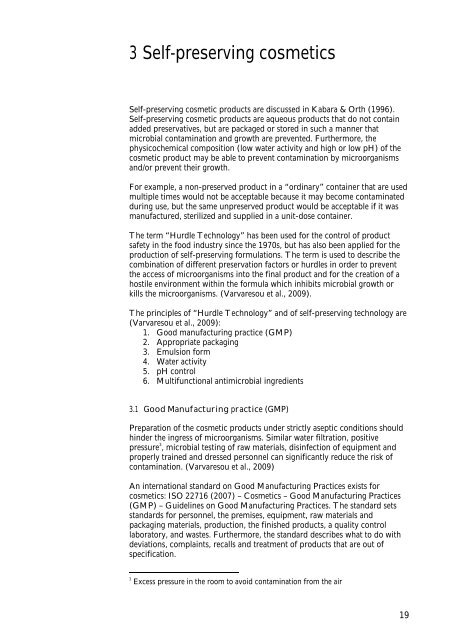Survey and health assessment of cosmetic products ... - Miljøstyrelsen
Survey and health assessment of cosmetic products ... - Miljøstyrelsen
Survey and health assessment of cosmetic products ... - Miljøstyrelsen
Create successful ePaper yourself
Turn your PDF publications into a flip-book with our unique Google optimized e-Paper software.
3 Self-preserving <strong>cosmetic</strong>s<br />
Self-preserving <strong>cosmetic</strong> <strong>products</strong> are discussed in Kabara & Orth (1996).<br />
Self-preserving <strong>cosmetic</strong> <strong>products</strong> are aqueous <strong>products</strong> that do not contain<br />
added preservatives, but are packaged or stored in such a manner that<br />
microbial contamination <strong>and</strong> growth are prevented. Furthermore, the<br />
physicochemical composition (low water activity <strong>and</strong> high or low pH) <strong>of</strong> the<br />
<strong>cosmetic</strong> product may be able to prevent contamination by microorganisms<br />
<strong>and</strong>/or prevent their growth.<br />
For example, a non-preserved product in a “ordinary” container that are used<br />
multiple times would not be acceptable because it may become contaminated<br />
during use, but the same unpreserved product would be acceptable if it was<br />
manufactured, sterilized <strong>and</strong> supplied in a unit-dose container.<br />
The term “Hurdle Technology” has been used for the control <strong>of</strong> product<br />
safety in the food industry since the 1970s, but has also been applied for the<br />
production <strong>of</strong> self-preserving formulations. The term is used to describe the<br />
combination <strong>of</strong> different preservation factors or hurdles in order to prevent<br />
the access <strong>of</strong> microorganisms into the final product <strong>and</strong> for the creation <strong>of</strong> a<br />
hostile environment within the formula which inhibits microbial growth or<br />
kills the microorganisms. (Varvaresou et al., 2009).<br />
The principles <strong>of</strong> “Hurdle Technology” <strong>and</strong> <strong>of</strong> self-preserving technology are<br />
(Varvaresou et al., 2009):<br />
1. Good manufacturing practice (GMP)<br />
2. Appropriate packaging<br />
3. Emulsion form<br />
4. Water activity<br />
5. pH control<br />
6. Multifunctional antimicrobial ingredients<br />
3.1 Good Manufacturing practice (GMP)<br />
Preparation <strong>of</strong> the <strong>cosmetic</strong> <strong>products</strong> under strictly aseptic conditions should<br />
hinder the ingress <strong>of</strong> microorganisms. Similar water filtration, positive<br />
pressure 3<br />
, microbial testing <strong>of</strong> raw materials, disinfection <strong>of</strong> equipment <strong>and</strong><br />
properly trained <strong>and</strong> dressed personnel can significantly reduce the risk <strong>of</strong><br />
contamination. (Varvaresou et al., 2009)<br />
An international st<strong>and</strong>ard on Good Manufacturing Practices exists for<br />
<strong>cosmetic</strong>s: ISO 22716 (2007) – Cosmetics – Good Manufacturing Practices<br />
(GMP) – Guidelines on Good Manufacturing Practices. The st<strong>and</strong>ard sets<br />
st<strong>and</strong>ards for personnel, the premises, equipment, raw materials <strong>and</strong><br />
packaging materials, production, the finished <strong>products</strong>, a quality control<br />
laboratory, <strong>and</strong> wastes. Furthermore, the st<strong>and</strong>ard describes what to do with<br />
deviations, complaints, recalls <strong>and</strong> treatment <strong>of</strong> <strong>products</strong> that are out <strong>of</strong><br />
specification.<br />
3<br />
Excess pressure in the room to avoid contamination from the air<br />
19

















